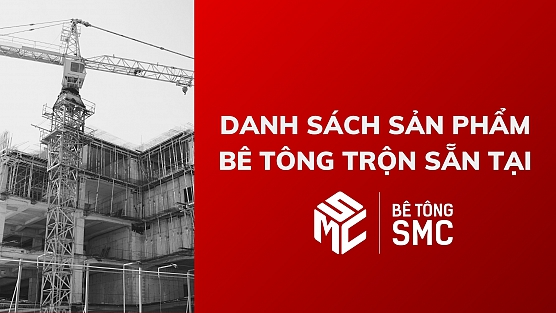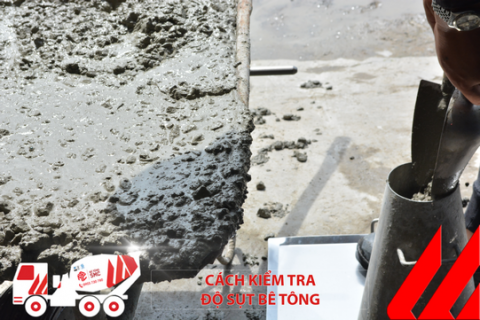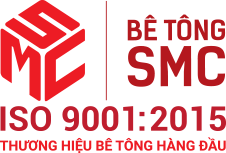Frequently asked Questions
Concrete engineering advice
Business contact
Requirements with water mixed concrete
Technical requirements for water used for mixing concrete, grouting, washing aggregate and curing concrete are specified in National Standard TCVN 4506: 2012.
Accordingly, water for mixing concrete , mortar, aggregate washing and curing of concrete should meet the following requirements:
• Does not contain oily scum or grease.
• The amount of organic impurities is not greater than 15 mg / L.
• pH is not less than 4 and not greater than 12.5.
• No color when used for concrete and decorative mortar.
For the purpose of use, the content of dissolved salts, the amount of sulfate ions, the amount of chlorine ions and the insoluble residue cannot be greater than the values specified in Table 1 (for concrete and mortar mixers) and Table 2 (for with water used for washing aggregate and curing concrete).
In addition, there are other technical requirements for concrete and mortar mixing water:
• The setting time of cement and the compressive strength of the mortar must meet the values specified in Table 3.
• The total equivalent amount of alkali converted to Na2O should not be greater than 1 000 mg / L when used with aggregates likely to cause alkali - silicon reactions.
Table 1 - Maximum permissible levels of dissolved salts, sulfate ions, chloride ions and insoluble residues in concrete and mortar mixers
Unit in milligrams per liter (mg / L)
| Uses | Maximum content allowed | |||
| Salt dissolved | Sulfate ion (SO 4 -2 ) | Chlorine ion (Cl-) | The insoluble residue | |
| 1. Concrete-mixing water and water-mixing grout pump protect reinforcement for pre-stressed reinforced concrete structures. | 2 000 | 600 | 350 | 200 |
| 2. Concrete mixing water and mortar-mixing water insert joints for reinforced concrete structures . | 5 000 | 2 000 | 1 000 | 200 |
| 3. Concrete mixing water for non-reinforced concrete structures. Water mixed with construction mortar and plaster. | 10 000 | 2 700 | 3 500 | 300 |
| NOTE 1 When using high alumina cement as a binder for concrete and mortar, the water used for all areas of use must comply with the provisions of Section 1, Table 1. NOTE 2 In case of necessity, water with chloride ion content in excess of Clause 2 of Table 1 may be used to mix concrete for reinforced concrete structures, if the total chlorine ion content in concrete is used. Not exceeding 0.6 kg / m3. Note 3: In the case of water used to mix masonry, plastering structures that require surface decoration or in parts that are frequently exposed to moisture, the chlorine ion content is controlled not exceeding 1 200 mg / L. . |
||||
Table 2 - Maximum permissible levels of dissolved salts, sulfate ions, chloride ions and insoluble residues in water used for washing aggregate and curing concrete
Unit in milligrams per liter (mg / L)
| Uses | Maximum content allowed | |||
| Salt dissolved | Sulfate ion (SO 4 -2 ) | Chlorine ion (Cl-) | The residue does not dissolve | |
| 1. Concrete curing water of structures that require surface decoration. Washing water, watering and wet sieving aggregate. | 5 000 | 2 700 | 1 200 | 500 |
| 2. Concrete curing water of structures without surface decoration (except water discharge works) | 30 000 | 2 700 | 20 000 | 500 |
| 3. Wet water stops before pouring concrete to wet concrete surfaces before inserting joints. Water curing concrete in the works of discharging and cooling concrete in the heat exhaust pipes of large blocks | 1 000 | 500 | 350 | 500 |
| Note: When using high alumina cement as a binder for concrete and mortar, water used for washing aggregate and curing of concrete must comply with the provisions of Section 1, Table 1. | ||||
Table 3 - Requirements for setting time of cement and compressive strength of mortar
| Targets | Limited value |
| Setting time of cement, min - Start, not less - Finish, not bigger |
45 420 |
| The compressive strength of mortar at 7 days should not be less than,% (percentage compared to the control sample) | 90 |
| Note: The control sample using domestic water (meeting QCVN 02: 2009 / BYT) is conducted in parallel and using the same cement with the test sample. | |
Other news
Currently, ready-mix concrete is a top choice for many construction projects—both large and small—thanks to its convenience, consistent quality, and high construction efficiency. With extensive experience supplying commercial concrete for numerous key projects in the Southern region, SMC proudly offers a diverse range of ready-mix concrete products to meet the technical requirements of every type of construction.
A Comprehensive Guide to Concrete Specs – Everything You Need to Know
A Complete Guide to Concrete Specs – a set of technical parameters including concrete grade, slump, compressive strength, aggregate size, and mix ratio. This article helps you understand how to define, apply, and control concrete quality according to TCVN standards and practical construction conditions.
How to check the concrete slump
In construction and civil engineering, concrete slump test (or simple slump test) is the work performed at the construction site or in the laboratory that usually determines and measures the hardness, consistency of samples. Concrete before pouring concrete or casting maintenance, research or experiment samples.




